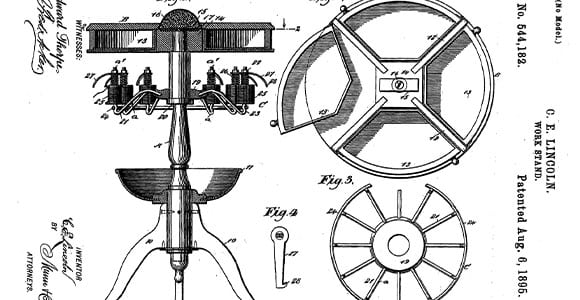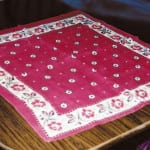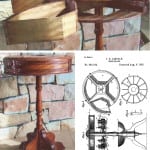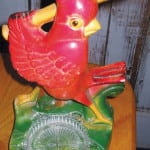I have what I think is a women’s handkerchief that was given to me by my adopted father. It measures 21 inches by 23 inches. There’s a print in the center outlined in beautiful flowers. The name in the corner is “Martha Washington. S.H. Greene & Sons.” The note that was pinned to it said it was given to my father’s grandmother from her boyfriend in 1884.
Could you tell me something about this handkerchief and its current value?
Delores, Lebanon
Dear Delores,
Printed textiles were mass-produced beginning in the late 1800s. This Martha Washington bandanna was made in Warwick, R.I., by the Clyde Bleachery and Print Works. The company bleached, then printed various patterns on cotton yardage. Patterns celebrating the nation’s centennial like this one sell for $50 to $100.
This table was in my grandfather’s office in the 1950s. Inside the pull-out drawers there is a stamp that says, “Lincoln’s Improved Work Stand, Patented… 1896…Manufactured by Specialty Manufacturing Co. Morehead City, NC.” A search of patents indicates it was a rug hooking stand originally. Any information you can provide would be helpful.
Carolyn, Banner Elk, N.C.
Dear Carolyn,
Thank you for taking the time to research the patent and for sharing that information. The description provided by the inventor, Clinton E. Lincoln, is written in the style of the Victorian period. He says his invention “has for its object to provide a stand that will embody a cabinet for the reception of scissors, buttons, thimbles, and said cabinet being provided with a number of drawers, and which will likewise serve as a table, and likewise…”
Sewing tables were a stylish way to work on textile projects and keep the family’s clothing in good repair. Their small size made them easy to move nearer a sunlit window. They were a luxury, though, and are a rare find in perfect condition. Your table had a turned wood knot that filled the hole on top, and there was a little bin under the drawers that held supplies. In its original condition a buyer might pay more than $1,800 for the table. As is, your table may not bring $100.
This is memorabilia from the early 1950s. It was purchased at a St. Louis Cardinals ballgame. I also have a souvenir program card from the game with autographs. Do you know its value? It appears to be made from plaster.
R.H., Humbolt
Dear R.H.,
Chalk ashtrays are a collectible category, even without the baseball team affiliation. This redbird would sell for around $20 in an antique mall. Combining the game-day program and autographs with your ashtray might increase its value. If the program was actually signed by recognizable ballplayers, a higher value could be significant. The first plan of action on your part would be to examine the autographs with a magnifying glass. If you see dots in the autograph ink, the deal’s off. It means it was printed. If you cannot and the player is well known, proceed to a professional autograph authenticator.






